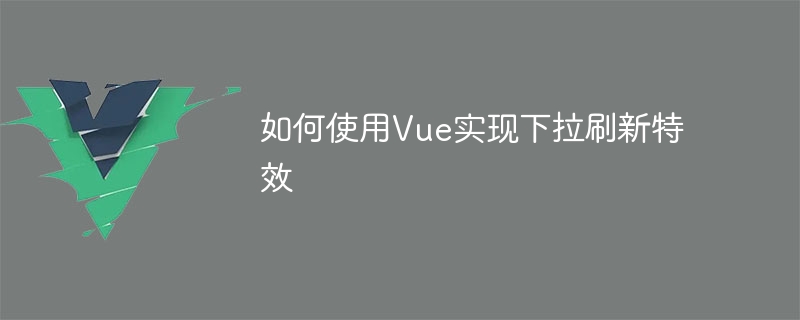

How to use Vue to implement pull-down refresh effects
With the popularity of mobile devices, pull-down refresh has become one of the mainstream application effects. In Vue.js, we can easily implement the pull-down refresh effect. This article will introduce how to use Vue to implement the pull-down refresh function and provide specific code examples.
First of all, we need to clarify the logic of pull-down refresh. Generally speaking, the process of pull-down refresh is as follows:
The following is a basic Vue component example, in which the pull-down refresh function is implemented:
<template>
<div class="pull-refresh"
@touchstart="handleTouchStart"
@touchmove="handleTouchMove"
@touchend="handleTouchEnd">
<div class="pull-refresh-content">
<!-- 数据展示区域 -->
</div>
<div class="pull-refresh-indicator" v-show="showIndicator">
<span class="arrow" :class="indicatorClass"></span>
<span class="text">{{ indicatorText }}</span>
</div>
</div>
</template>
<script>
export default {
data() {
return {
startY: 0, // 记录用户手指触摸屏幕的纵坐标
distanceY: 0, // 记录用户手指拖动的距离
showIndicator: false, // 是否显示下拉刷新指示器
indicatorText: '', // 指示器文本
loading: false // 是否正在加载数据
}
},
methods: {
handleTouchStart(event) {
this.startY = event.touches[0].clientY
},
handleTouchMove(event) {
if (window.pageYOffset === 0 && this.startY < event.touches[0].clientY) {
// 说明用户是在页面顶部进行下拉操作
event.preventDefault()
this.distanceY = event.touches[0].clientY - this.startY
this.showIndicator = this.distanceY >= 60
this.indicatorText = this.distanceY >= 60 ? '释放刷新' : '下拉刷新'
}
},
handleTouchEnd() {
if (this.showIndicator) {
// 用户松开手指,开始刷新数据
this.loading = true
// 这里可以调用数据接口,获取最新的数据
setTimeout(() => {
// 模拟获取数据的延迟
this.loading = false
this.showIndicator = false
this.indicatorText = ''
// 数据更新完成,重新渲染页面
}, 2000)
}
}
},
computed: {
indicatorClass() {
return {
'arrow-down': !this.loading && !this.showIndicator,
'arrow-up': !this.loading && this.showIndicator,
'loading': this.loading
}
}
}
}
</script>
<style scoped>
.pull-refresh {
position: relative;
width: 100%;
height: 100%;
overflow-y: scroll;
}
.pull-refresh-content {
width: 100%;
height: 100%;
}
.pull-refresh-indicator {
position: absolute;
top: -60px;
left: 0;
width: 100%;
height: 60px;
text-align: center;
line-height: 60px;
}
.pull-refresh-indicator .arrow {
display: inline-block;
width: 14px;
height: 16px;
background: url(arrow.png);
background-position: -14px 0;
background-repeat: no-repeat;
transform: rotate(-180deg);
transition: transform 0.3s;
}
.pull-refresh-indicator .arrow-up {
transform: rotate(0deg);
}
.pull-refresh-indicator .loading {
background: url(loading.gif) center center no-repeat;
}
</style>In the above code, we define a component named "pull-refresh "Vue component, which implements the logic of pull-down refresh effects. Three events are triggered in the component: touchstart, touchmove and touchend, which respectively handle user pull-down operations, user drag operations and user release finger operations.
When processing user drag operations, we use the event.preventDefault() method to prevent the default scrolling behavior of the page to ensure that the drop-down operation can be triggered normally.
When processing the user's finger release operation, we control the display and hiding of the indicator, as well as the text content of the indicator, by modifying the data of the component. At the same time, we used the setTimeout method to simulate the operation of delayed loading of data to show the effect of pull-down refresh.
Finally, we dynamically set the style class of the indicator through the calculated attribute indicatorClass to achieve the effect of rotation in the direction of the arrow and loading animation.
The above code is just a simple example, you can extend and modify it according to actual needs. I hope this article can help you understand how to use Vue to implement pull-down refresh effects, and provides specific code examples for your reference.
The above is the detailed content of How to use Vue to implement pull-down refresh effects. For more information, please follow other related articles on the PHP Chinese website!